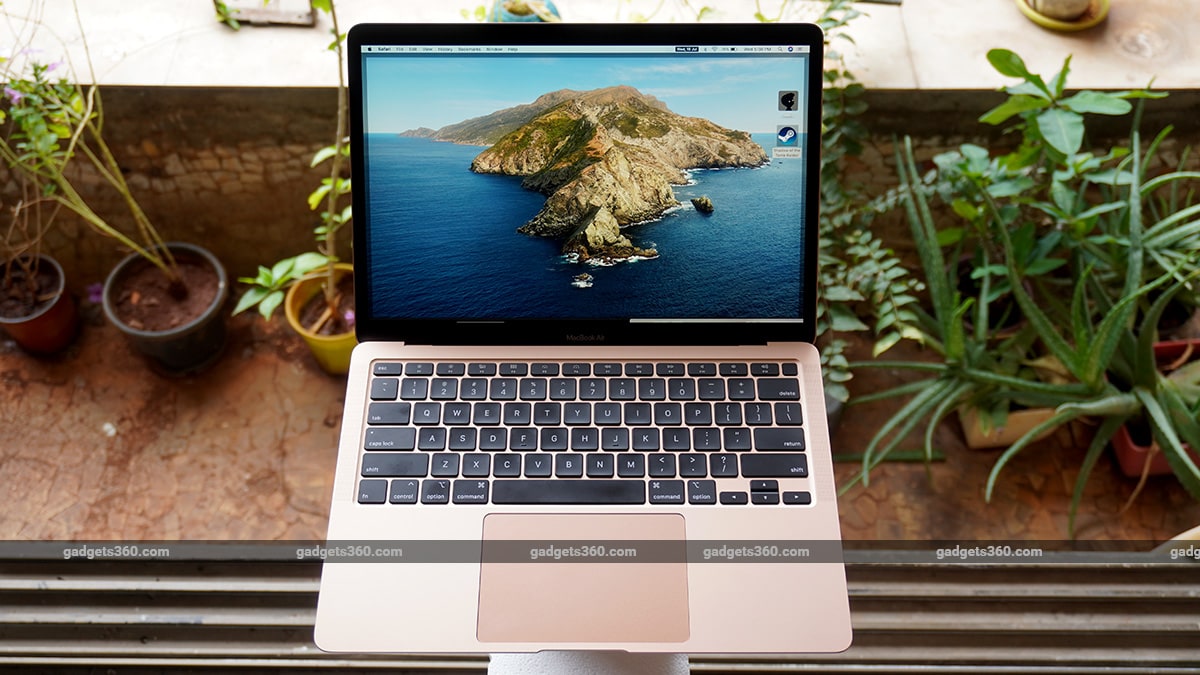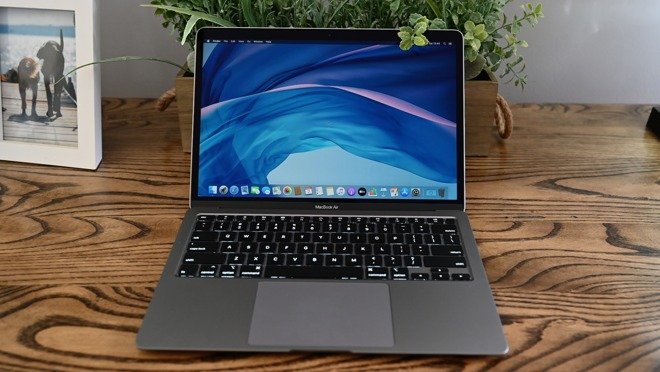Apple’s MacBook Air does not need introduction. It’s long been the go-to laptop for professionals and students, and in 2018, it got even better when Apple finally overhauled the design. However, the shallow keyboard that Apple introduced with that revision has been criticised quite heavily. Today, we’ll be reviewing the latest 2020 model of the MacBook Air, which promises an improved keyboard based on customer feedback.
The new MacBook Air (2020) boasts of three major changes compared to its predecessor — a new Magic Keyboard, 10th Gen Intel processors, and 256GB of storage for the base variant (up from 128GB). In a very non-Apple move, the official starting price of the laptop is also now roughly Rs. 7,000 lower, at Rs. 92,990. I’ve been using the base version of the MaBook Air (2020) as my primary laptop for a few days, and it’s time to see how much of a difference these changes have made.
MacBook Air (2020) design: Almost perfect
The MacBook Air (2020) continues with the same design of the 2018 refresh, but is just slightly thicker and heavier. If you’re used to the older non-Retina MacBook Air, like I am, then there’s a lot that’s new. The overall size of the laptop is smaller, making it a lot more portable, and it’s a bit lighter too, starting at 1.29kg. The entire body is built using 6000-series aluminium, which makes it feel very sturdy. The Apple logo on the lid isn’t backlit anymore, but instead features a mirror finish, which complements the matte finish on the rest of the body.

The “gold” MacBook Air (2020) that I have more closely resembles rose gold, and looks a lot better than the rose gold finish of some older iPhone models. If you want to make a statement every time you visit a Starbucks, then I can see the appeal of the gold option. I’d still pick the silver or space grey colours over this, but that’s just a personal choice.
The 13.3-inch IPS Retina display looks great and is a big step up from the non-Retina model, with a much higher resolution of 2560×1600 pixels. You also get Apple’s True Tone technology, which automatically adapts the colour temperature of the display to ambient light. The bezels around the display are slimmer too, which makes the laptop look more modern. One thing that I found a little odd was that the upper corners of the display aren’t rounded, but the ones at the bottom are. While the aluminium lid offers plenty of protection, the display still flexes easily when you touch it with a bit of pressure.
The new keys feel very responsive thanks to the 1mm of travel and aren’t noisy when you type. The key layout is very familiar, except for the power button, which is smaller compared to the non-Retina model. It also houses Apple’s Touch ID fingerprint sensor. The latter works well with just a tap and is useful for logging in to the system, authorising app downloads, and when you need to autofill credentials for websites in Safari.

The MacBook Air (2020) has stereo speakers, one on each side of the keyboard. Apple says it can deliver twice the bass and up to 20 percent higher volume compared to the non-Retina model. There are a total of three microphones placed around the laptop, and thanks to the dedicated T2 security chip, you can use the ‘Hey Siri’ voice command to summon Siri at will. The trackpad is 20 percent larger compared to the non-Retina model and feels just as responsive as before. Despite the increase in size, I didn’t face any accidental presses or cursor movements while typing.
The trackpad also supports Force Touch, which means you get haptic feedback when you press down on any part of it. There’s also a Force Click gesture that you perform by continuing to apply pressure after the click registers. You feel a stronger haptic pulse to know you’ve performed the action. I found it to be quite handy for previewing images and documents.
The physical connectors on the MacBook Air (2020) have been reduced to just two Thunderbolt 3 Type-C ports and a headphone jack. The 2020 refresh now supports one 6K or up to two 4K external displays through the Type-C ports. The problem with having just Type-C ports is that connecting most common accessories to the laptop is next to impossible without an adapter. Ideally, you’ll want to invest in a Type-C hub which has connectors for USB Type-A ports, Ethernet, and maybe an SD card reader. If you’re already in the Apple ecosystem, transferring anything between Apple devices is at least less of a problem, thanks to AirDrop.
MacBook Air (2020) specifications and software: Up to date
Another big change with the 2020 refresh is the processor. The MacBook Air (2020) now features Intel’s 10th generation CPUs, which promise better processing capabilities than the previous Retina MacBook Air. I’m testing the base model, which has an Intel Core i3-1000NG4 ‘Ice Lake’ CPU, with two cores and four threads. It’s built on the 10nm fabrication process and features Intel’s Iris Plus integrated graphics. The base version of the laptop also has 8GB of LPDDR4X RAM and a 256GB PCIe SSD.
Apple India sells another pre-built model with a quad-core Intel Core i5 CPU, 8GB of RAM, and a 512GB SSD for Rs. 1,22,990. In addition, since May this year, you can customise Mac configurations through Apple Authorised Resellers in India. With this flexibility, you can opt for a quad-core Core i7 CPU, up to 16GB of RAM, and up to 2TB of SSD storage. The MacBook Air (2020) also features dual-band Wi-Fi ac, Bluetooth 5, an HD webcam, and a 50Wh battery with a claimed 11-hour battery life.
My only complaint is that 720p is a fairly low resolution for a webcam in 2020, and the footage it captures is generally a bit grainy, even in well-lit environments.
The MacBook Air (2020) ships with macOS 10 Catalina, and will get a free upgrade to macOS 11 Big Sur when it releases in a coupe of months. The MacBook Air (2020) also supports the Sidecar feature of macOS, which lets you use a compatible iPad as a second display, wirelessly. You can read about all the main features of Catalina right here. The latest 10.15.5 update also added a new battery health management feature for MacBooks to help maximise the lifespan of your battery.
MacBook Air (2020) performance and battery life: Good enough
If you’re coming from a non-Retina Core i5 MacBook Air like I am, then switching to a Core i3 CPU might seem like a downgrade, but it actually isn’t. Intel’s current 10th-generation ‘Ice Lake’ Core i3 processor in the MacBook Air (2020) is just as powerful, if not better in some ways than the fifth-generation ‘Broadwell’ Core i5 in the non-Retina model.
In the Cinebench R20 benchmark, the MacBook Air (2020) posted a very similar multi-core score of 626 points as the older MacBook Air, but the single-core score improved by roughly 24 percent, at 348 points. The MackBook Air (2020) posted 16.3fps in GFXBench Metal’s Aztec Ruins test, while my older MacBook Air managed 30fps. However, if we take resolution out of the equation, the Iris Plus graphics chip marches ahead. In the resolution-independent ‘offscreen’ version of the same test, the MacBook Air (2020) managed 29.2fps, while the non-Retina MacBook Air managed just 20fps. While the integrated GPU in the MacBook Air (2020) is better, it still struggles with graphically intensive tasks due to the higher-resolution display.
SSD performance has also been improved. In the AmorphousDiskMark benchmark, the MacBook Air (2020) averaged 1.63GBps and 1.15GBps in the read and write tests respectively. My non-Retina MacBook Air on the other hand managed to average 1.2GBps and 430MBps in the same tests.
I used the new MacBook Air (2020) as my primary work laptop for this review, and the performance was pretty solid throughout. MacOS booted up quickly, multitasking was relatively effortless, and the larger trackpad made gestures even easier to use. Editing images in Adobe Photoshop CC 2020 was also handled very well. There’s virtually no audible fan noise on the Core i3 model. The only time I heard it spinning was during a system update. I noticed that the bottom of the laptop was generally on the warmer side, whether I was watching a video or simply browsing the Web.
